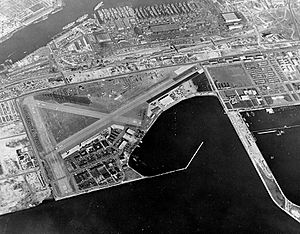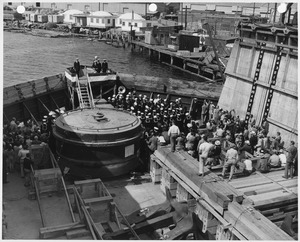Naval Air Base San Pedro facts for kids
Quick facts for kids Naval Air Base San Pedro |
|
|---|---|

Naval Air Base San Pedro on Terminal Island
|
|
| Location | San Pedro, California |
| Area | 410-acre |
| Built | 1927 |
| Architect | US Navy |
| Lua error in Module:Location_map at line 420: attempt to index field 'wikibase' (a nil value). | |
Naval Air Base San Pedro was an important airfield for the US Navy during World War II. It was a large base, about 410 acres, located on Terminal Island in San Pedro, California. This area is part of the City of Los Angeles.
Before the Navy used it, the airstrip was a civilian airport called Allen Field. Allen Field was built in 1927. Workers created it by filling parts of the Port of Los Angeles with sand. This made Terminal Island bigger. Terminal Island sits between San Pedro Harbor and Long Beach Harbor. People could reach Allen Field by Pacific Electric trains and ferries.
The airport had three runways shaped like a triangle. Two runways were short, and one was 4,200 feet long. There was also a large ramp for seaplanes. In 1927, a Naval Air Reserve Training Facility was built next to Allen Field. It shared the runways and seaplane ramp. Civilian use of Allen Field stopped in 1935. The site then became a Navy air base. Later, it was renamed Reeves Field San Pedro after Rear Admiral Joseph M. Reeves.
Training and Testing During World War II
In 1942, many Navy Reserve troops trained at Naval Air Base San Pedro. In 1943, the Navy took full control of the base. The Reserve training moved to Naval Air Base Los Alamitos. The base was then renamed Naval Air Station Terminal Island. It continued to be a training base until World War II ended in 1945.
Besides training troops, the base was used to test new airplanes. These planes were built in Southern California by companies like Lockheed, Douglas Aircraft Company, and Vultee Aircraft. A special unit called the Naval Air Ferry Command was created. It was part of the Naval Air Transport Service. This unit's job was to test these new planes and deliver them. The base worked all day and night, testing and shipping out about 200 planes each month.
In 1943, the U.S. Navy officially started the Naval Air Ferry Command (NAFC), also known as VRF-3. This unit helped deliver the many military aircraft made nearby. During the war, Captain Kneflar "Socko" McGinnis was the commander of the base.
During the war, there was a shortage of service members. Because of this, a unit of WAVES was stationed at the base. WAVES stands for Women Accepted for Volunteer Emergency Service. About 200 WAVES served at the base. They worked as mechanics, air traffic controllers, and radio operators. They also helped as trainers and air navigators. Their work was very important to the war effort.
After the War
After World War II ended, Naval Air Base San Pedro closed in 1947. The base was then given to the Bureau of Yards and Docks. The nearby Naval Air Base Long Beach continued to use the airfield. This continued until 1997, when the base was finally abandoned. Today, there are no visible traces of the base left.


